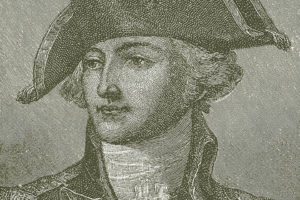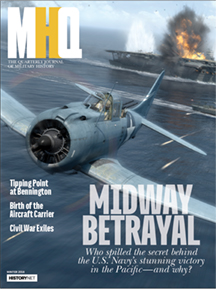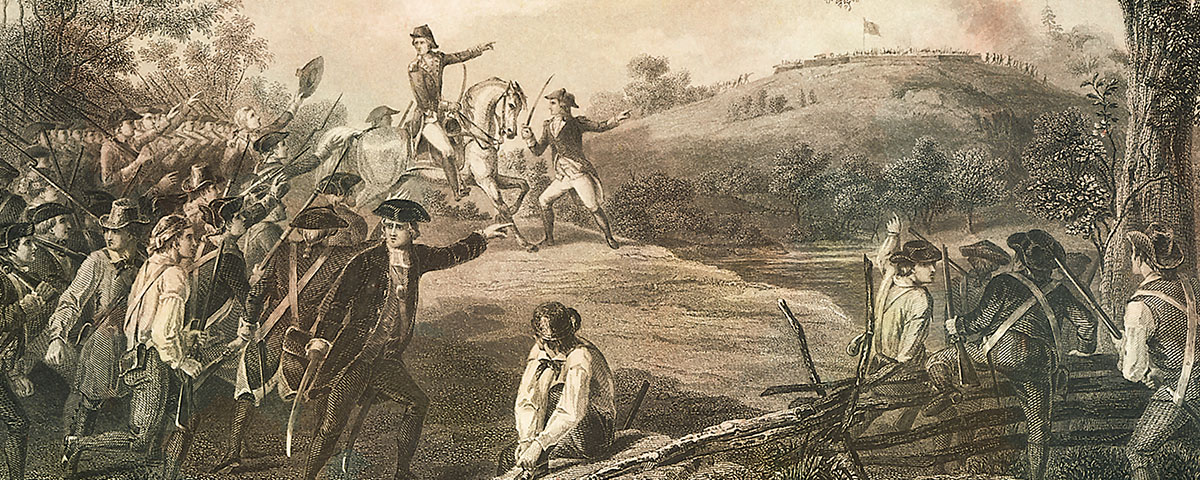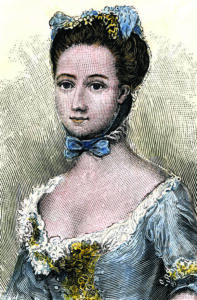In 1777 John Stark and his American forces handed the British a defeat from which they never recovered.
AMONG THE INNUMERABLE PAMPHLETS LITTERING LONDON COFFEE HOUSES in late 1776 was the provocative Letter to Lord George Germain. Credited only to “an Englishman,” it argued against a costly war with the disaffected American colonies and cautioned British generals who might “penetrate into the country; without oxen, without horses, [and] drag your cannon, your ammunition, your bread wagons, and your baggage through the woods, a cloud of rifle men in your front, in your rear, and upon your flanks.” Dismissing the ability of commissaries to supply troops in the thick American wilderness, the author added: “I would advise your Lordship to ask General [Thomas] Gage what it is to conduct an army through a wood in America, and what is the consequence of a defeat in a des[e]rt.”
Germain, Britain’s secretary of state for the colonies, had little use for the public’s advice. He had surely learned all he was going to from Gage, the former commander of British forces in America. He therefore anticipated only victories from an equally confident Lieutenant General John Burgoyne as the latter prepared to slash south from Quebec to Albany in the spring of 1777. But Burgoyne would stumble into a logistical nightmare on New York’s untamed frontier. There, his promising campaign would take a fateful turn, not far from the quiet hamlet of Bennington, Vermont.
Burgoyne’s offensive was part of a muddled British plan to end the Revolutionary War in 1777. The idea was to isolate irksome New England, with General William Howe moving north and Lieutenant Colonel Barry St. Leger advancing east to join Burgoyne at Albany. This, it was believed, would force General George Washington’s main army into a conclusive showdown. The problem with the scheme was that none of the principals involved—Germain, Burgoyne, Howe, or Major General Henry Clinton—were on the same page. But that fact remained for Burgoyne to discover.
AT FIRST, ALL WENT WELL. In June Burgoyne left Canada with some 7,800 men—roughly 4,000 British regulars and 3,100 Germans plus some Canadians, loyalists, and Indians. By July 1 he was knocking on the back door of Fort Ticonderoga, the crumbling, French-built fort now held by Major General Arthur St. Clair and 2,000 Americans. Within a week Burgoyne’s engineers had placed enough guns on dominating ground to force St. Clair into headlong retreat.

As outraged American politicians called for the head of Major General Philip Schuyler, the commander of the Northern Department, Burgoyne’s professionals hunted St. Clair’s strung-out force. On July 7, the bloodied American rearguard managed to slip away after a nasty clash with advance elements of Burgoyne’s army at Hubbardton, just across the border in the new state of Vermont, formerly the New Hampshire Grants. Burgoyne then ordered his men into Skenesborough, where they would rest and he would take stock. St. Clair headed south to rendezvous with Schuyler’s army at dilapidated Fort Edward, on the eastern bank of the Hudson River.
Burgoyne spent more than two weeks on the estate of Philip Skene, a former British officer who had stamped his name on a swath of land below Lake Champlain following the French and Indian War. The Crown eventually appointed him lieutenant governor of Ticonderoga and Crown Point. But by 1775 his connections had earned him John Adams’s condemnation as “an infernal scoundrel” and a year in a Connecticut prison. Now, Burgoyne was counting on Skene to draw loyalist volunteers and secure local caches of supplies and wagons.
While his hungry troops awaited supplies from Ticonderoga, Burgoyne dispatched Skene and Major General Friedrich Adolf Baron von Reidesel, his second in command, and a body of troops south to Castle Town. There, Skene rallied Tories while Reidesel’s men scrounged for horses, “wheeled carriages,” and intelligence. Meanwhile, Burgoyne rethought his next step on the road to Albany. Discarding his original plan to ship his army down Lake George to within a quick march of Fort Edward, where he would cross the Hudson, he decided to lead the army 23 miles overland.
Already, the complexion of Burgoyne’s campaign was changing. If the general was winning clashes on the battlefield, he was—thanks to a clogged supply line and zealous patriots who emptied homesteads of horses, oxen, food, and wagons—losing the struggle to keep his army fed and mobile. The animals straining to haul his artillery, ammunition, and equipment were even hungrier than his troops. The crude road ahead, meanwhile, promised headaches that only American woodsmen could provide. But Burgoyne had decided that retracing his steps to Lake George would send the wrong message to both his men and the enemy.
On July 24 Burgoyne’s columns trekked south. Ahead of them, Schuyler’s diligent axmen had turned the raw frontier trail into a formidable obstacle course by crisscrossing it with felled trees. It took Burgoyne’s exhausted troops a week to struggle through the bug-infested wilderness and stumble into Fort Edward. There they again plunked themselves down, happy to rest until enough provisions arrived to get them to Albany.
BY NOW, THOUGH, BURGOYNE WAS NO LONGER CONTENT TO WAIT. True, as he learned to his exasperation on August 3, Howe was headed south to Philadelphia, rather than north, but Burgoyne still had St. Leger’s eastbound force to consider. With a little haste he could trap Schuyler between his army and St. Leger’s or simply intimidate the Americans into moving out of his path. To do that he needed more of everything he lacked—immediately. “The alternative therefore was short,” Burgoyne would testify later: “either to relinquish the favourable opportunity of advancing upon the enemy, or to attempt other resources of supply.”
Accordingly, Burgoyne ordered a raid on the American supply depot at Manchester, Vermont. Lieutenant Colonel Friedrich Baum, accompanied by Skene, would lead the expedition. He had a lengthy to-do list. With some 750 men (including 200 footsore German dragoons who lacked horses), plus any loyalists who signed on, Baum was to clean out Manchester and then probe east before looping southwest to meet the army at Albany. Burgoyne expected him to return with at least 1,300 horses, along with oxen and sturdy American wagons packed with provisions. The general’s instructions to Baum included a reminder that his corps was “too valuable to let any considerable loss be hazarded on this occasion.”
As Baum was about to depart on August 13, he received new orders—for Bennington, Vermont, a handful of houses and a packed storehouse 30 miles to the southeast. Burgoyne credited the change to Skene’s tip that the lightly guarded village was ripe for a surprise. He would subsequently assert that he had targeted Bennington all along. Reidesel, citing mixed intelligence reports and the distance involved, protested—to no avail. So began what James Thacher, a surgeon who served with distinction in the Continental Army, would characterize in his wartime journal as “one of the most chimerical and romantic projects that could enter the imagination of man.”
The mission bore considerable risk. The Americans could hardly have failed to appreciate the lure of either village. And by now they had had five weeks to prepare. In that time Schuyler had dispatched Colonel Seth Warner, the commander of the fabled Green Mountain Boys and a Bennington resident, to organize the defense of “the inhabitable part of the country.” Those considered susceptible to Skene’s clemency offers were hustled south. Meanwhile, Vermont’s Council of Public Safety had dispatched express riders with appeals for help to New Hampshire and Massachusetts—emphasizing that “the Continental Stores at Bennington seem to be their [the enemy’s] present aim.”
New Hampshire officials had responded by giving 49-year-old native son John Stark a brigadier general’s commission, a brigade of militia, and orders to act for the “protection of the People or the annoyance of the Enemy.” A man of considerable grit, Stark had fought in the French and Indian War and made a name for himself at Breed’s Hill and Trenton. Then, in early 1777, he had quit the army, lost in the shuffle of political favorites promoted ahead of him. Burgoyne’s campaign, then, had resuscitated his military career. And at Fort No. 4, in Charleston, New Hampshire, militiamen were filling his brigade with unusual speed. By the end of July Stark had sent 700 men to Warner. When Stark marched for Manchester on August 3 with 300 more, recruits were still coming in.
Once Baum’s column finally moved out, it took 12 hours to cover the 16 miles of rough road to Cambridge, New York. There, after his advance party traded shots with a handful of thoroughly unsurprised rebels, Baum learned that up to 1,800 Americans awaited him at Bennington. A similar scene played out the next morning at the mill village of Sancoick. Baum subsequently dashed off a note informing Burgoyne of his intent to attack the enemy the following morning. Captured rebels, he noted, had confirmed the size of the force up the road but asserted that it was “supposed to leave on our approach.”
Sancoick provided Baum with a hefty haul of flour and wheat. Gathered livestock was stretching his column. But the colonel, who spoke no English, had his hands full. The Indians in his command—who expected immediate payment for horses they rounded up—were petulantly driving them off as the expedition commander demurred. All the while, antsy locals were eyeing the British and German troops with curiosity. It was up to Skene, who had been away from the region for most of the last two years, to distinguish loyalist from rebel. Certainly, there was no doubting the intent of rifle-toting men who wrecked the bridge out of Sancoick. At this point, with any hope of surprising the enemy dashed, Baum should have exercised more caution.
But, reassured by Skene, he marched on. Baum’s troops had reached a bridge four miles west of Bennington on the afternoon of August 14 when, opposite a bend in the Walloomsac River, the much-rumored American force loomed up before him. At its head were Stark and Warner. Stark, who had marched to Bennington and put himself in position to react when word of Baum’s approach reached him, had sent 200 militiamen to slow Baum down. It was some of these men who had dashed in and out of Sancoick ahead of the Germans.
Now, eyeing the colorful British force across the river, Stark tried to lure Baum from his “very advantageous piece of ground.” Baum didn’t move. Stark then withdrew a mile to consider his options, leaving skirmishers on harassment duty until dark. Amid American potshots Baum’s men staked out a position that extended uphill from the bridge. On the lower portion of this rise, overlooking the junction, Baum posted his two guns.
Meanwhile, across 25 miles of terrain, Baum was trading slow-moving messages with Burgoyne. On the night of the 14th Burgoyne asked for all available cattle and wagons. He also instructed Baum, “Should you find the enemy too strongly posted at Bennington, and maintaining a countenance as may make an attack imprudent, I wish you to take a post where you can maintain yourself till you receive an answer from me, and I will either support you in force, or withdraw you.” Burgoyne then decided to send support regardless and dispatched his aide-de-camp, Sir Francis Clarke, with marching orders for Lieutenant Colonel Heinrich Breymann. With 650 men and two 6-pounder guns, Breymann would strike out after Baum the next morning.
Peering east into the darkness, Baum fully grasped the threat before him. Now, he noted in his final response to Burgoyne, “as the enemy have collected their force, and from their countenance must have had intelligence of ours, [I] would not think it advisable to risk a repulse.” He was still scribbling when a note from Clarke arrived, alerting him to Breymann’s inbound relief force. This news, coupled with Skene’s encouraging reports of loyalists seeking a place in his little army, affirmed his decision to stay put.
The problem was, Baum was essentially on an island, a fact that some of his jittery subordinates recognized. “A report came that the Breymann Corps was on its way to help us,” wrote J. F. Wasmus, a German surgeon. “Would that this be true or that we would withdraw but to the bridge at the mill at Sancoick. We would be much safer there than here where every 40 paces a man is standing behind a tree.”
Equally alarming was Baum’s apparent indifference to security. “The inhabitants around here come and go through our camp,” Wasmus noted. “They will surely give the enemy information of our weakness.”
August 15 brought enough rain to swamp both armies. With firing all but impossible, Baum’s soaked troops labored to throw up redoubts. Atop the wooded hill that shadowed the bridge, loyalists muscled mud and logs into a broad barricade facing northwest, behind which Baum shifted 60 of his dragoons and one cannon.
Nearly a half-mile south, on a rise along the river’s eastern bank, loyalists and German grenadiers dug in behind scavenged fence rails and earth. In between, Baum stood with 200 tense British and German troops. A handful of others guarded piles of baggage and scores of unlucky oxen and horses. Baum lacked the numbers to hold such an extended position for long. Barring disaster, however, he would not need to.
Disaster is what he got. The next day, sunshine drove off the rain and Stark went to work. He’d had two days to sharpen a plan based on detailed reports of Baum’s position. It was not complicated: Divided in three, his army would blitz Baum’s exposed flanks and center simultaneously. Some 600 men—under Lieutenant Colonel Moses Nichols, circling to the northwest, and Colonel Samuel Herrick, slashing up across the river—would pinch off the northern redoubt. Taking the riverside redoubt fell to 200 men under Colonels Thomas Stickney and David Hobart. Stark would rush Baum’s center with the rest of his assault force.
Into the early afternoon American flanking troops shuffled through underbrush toward their jump-off positions. At 3 p.m. Stark unleashed them. The shouts of startled dragoons filled the air as Americans opened fire on the hilltop redoubt from two sides. The Germans answered with their 3-pounder and steadfast volleys, but they were outgunned. Within minutes all of the artillerists were down. Bellowing rebels poured into the redoubt to hammer the unfortunate defenders with their rifles. Desperate Germans scrambled to get out of the blood-tinged muck, half-running and half-sliding down the hill. Scores of the luckier ones were taken prisoner.
Across the river 200 Americans emerged from a screen of trees and cornstalks to surprise the loyalists within the lower redoubt. Amid an explosion of fire, Lieutenant John Orr recalled later, “an expression of the Prince of Orange came into my mind, ‘every bullet has its billet,’ and I soon found one commissioned to lay me low.” Orr was one of the few militiamen wounded as they closed on, and then swarmed over, the makeshift wall. In intensely personal fighting, former neighbors tangled with the bitterness of age-old enemies. Overwhelmed loyalists vacated their trenches. But the Walloomsac limited their chances of escape.
The results were no different in the center. As Baum’s flanks collapsed, Stark’s militia pressed British and German defenders, who were desperately loading and firing. The sudden explosion of a British ammunition cart punctuated battle noise that Stark described as “one continual clap of thunder.” Baum and his sword-wielding Germans tried to carve an escape route, but there was nowhere to go. “All was confusion,” recalled Vermonter Jesse Field. Amid the chaos, Baum fell with a death wound, a bullet in his abdomen.
Shortly after 5 p.m., Breymann’s miserable, mud-covered reinforcements finally reached the scene. The previous day’s rains, combined with other misfortunes, from an upset ammunition wagon to a confused guide, had limited the column to a snail’s pace. At Sancoick a waiting Skene apprised Breymann of events. Breymann then set out to find Baum, “unaware that [Baum’s] fate was already sealed,” as Breymann later wrote. “If Colonel Skene was acquainted with that fact at this time, then I cannot imagine what could have induced him to keep it from me; for, in such a case, I certainly would not have risked an engagement.”
What Breymann found was a scattered and vulnerable enemy. To hundreds of relieved Americans, the battle had already been won. Those not injured or herding prisoners were savoring mouthfuls of rum or roaming the hills in search of souvenirs. Stark and his subordinates were trying to reorganize the army as Breymann’s pent-up men began trading shots with surprised patriots on sloping ground west of the bridge. As Breymann’s gunners opened up with their 6-pounders, his line slowly ground its way east.
The terrain scarcely suited the methodical Germans. “To fight in desolate forests and thick underbrush is ticklish work,” one later wrote, “and one company in advance of another can easily become fortunate or unfortunate.” Few of Breymann’s men got close enough to harm Americans darting from tree to tree. That gave Stark and Warner breathing room as they rounded up exhausted and bewildered men. Gradually, a line of sweat-soaked troops coalesced behind a fence. With fortunate timing, a just-arrived regiment of Massachusetts militia entered the fight. Warner’s Green Mountain Boys then turned the tide.
Only 150 men of this hard-fighting regiment remained. At Stark’s request, Warner’s second-in-command, Major Samuel Safford, had marched them down from Manchester the previous day. Now, the fiery Warner pointed them through the trees on Breymann’s left and, in a voice loud enough to be heard above the crackling musketry, bellowed “Fix Bayonets!” followed by “Charge!” That was enough to convince Breymann’s frazzled troops, many of whom had burned through their allotted 40 cartridges, to begin lumbering west. Stragglers wound up in the bulging American bag of prisoners. Breymann barely survived a vain attempt to save his guns before dimming skies finally ended the affair.
Word of Baum’s repulse, followed by the tattered remains of the expeditionary forces, reached Burgoyne the following day. Left behind were nearly 1,000 men, including 207 dead. (There were fewer than 150 American casualties.) Gone, too, were the fresh horses and wagons with which Baum was to have returned. Dismissing any possibility of a retreat to Ticonderoga, Burgoyne prepared to cross the Hudson and turn for Albany despite his enfeebled supply lines.
Publicly, Burgoyne dismissed the debacle as a mere “check.” Baum and Breymann had fought courageously, he noted. But the former had not followed instructions that emphasized caution. The latter had worried too much about his cumbersome cannons and not enough about his objective. The general seethed about the loyalist Skene, who had been “so incautious as to leave at liberty such as took the oath of allegiance.” But, like Skene, Burgoyne had learned too late that “the great bulk of the country is undoubtedly with the Congress, in principle and in zeal; and their measures are executed with a secrecy and dispatch that are not to be equaled.” He had also discovered that, despite its flaws, the American militia system was well-suited to just this sort of emergency. As Burgoyne dallied at Fort Edward, the colonies had produced an army—one unburdened, this time, with the specter of expiring enlistments. And unfortunately for Baum, the hard-bitten Stark knew he had to beat the enemy to the punch.
Burgoyne might have sent more troops or lighter, speedier units. But it was the nagging transportation and supply shortage that put him in a bind to begin with. Both he and Germain knew that traversing New York’s wilds would require ample carts and provisions, which, Burgoyne reported, “can only be supplied from Canada.” But the campaign’s architect had moved south anyway, with a deficit that proved impossible to make up on the march.
BURGOYNE’S NIGHTMARE WAS JUST BEGINNING. In late August, St. Leger abandoned his siege of Fort Stanwix and his drive for Albany. That set Burgoyne up for an ignominious defeat at the hands of Major General Horatio Gates’s still-growing army of 10,000 on the hills of Saratoga. The eye-popping size of the revitalized American force reflected a flurry of actions. Washington had reinforced it with Continental troops and Major Generals Benjamin Lincoln and Benedict Arnold. This, combined with Congress’s subsequent replacement of Schuyler with the more popular Gates, had jolted New England militia enlistments. The electrifying performance of Stark’s militia tipped the scales entirely against Burgoyne. “One more such stroke,” Washington wrote optimistically, “and we shall have no great cause for anxiety as to the future designs of Britain.”
The Gates-Burgoyne showdown at Saratoga reduced the Battle of Bennington to footnote status. The dark outcome of Baum’s ill-fated expedition, however, would haunt British officers until the war’s end. “You will easily perceive the difficulties that an army offering to penetrate this country must encounter,” British lieutenant colonel James Stuart had observed in a letter to his brother just months before General Charles Cornwallis’s 1781 surrender at Yorktown, Virginia. “I sincerely wish that they may be well understood by our general, that no fatal consequences may ensue.” MHQ
ERIC ETHIER has written for American History, Civil War Times, and Military History, among other publications. He lives in Attleboro, Massachusetts.
[hr]
This article appears in the Winter 2018 issue (Vol. 30, No. 2) of MHQ—The Quarterly Journal of Military History with the headline: Tipping Point
Want to have the lavishly illustrated, premium-quality print edition of MHQ delivered directly to you four times a year? Subscribe now at special savings!






